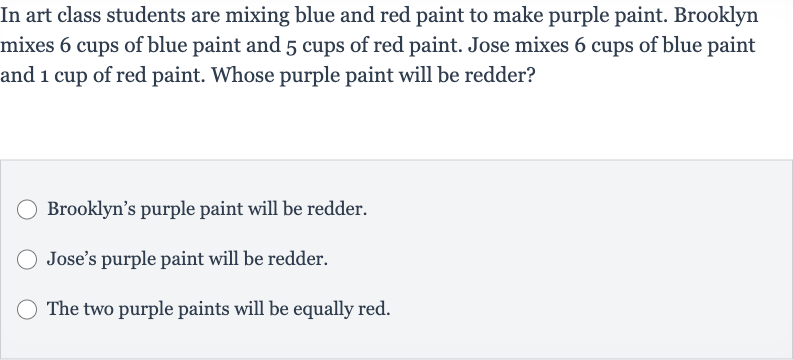AI tutor
Welcome to Bytelearn!
Let’s check out your problem:

In art class students are mixing blue and red paint to make purple paint. Brooklyn mixes cups of blue paint and cups of red paint. Jose mixes cups of blue paint and cup of red paint. Whose purple paint will be redder?Brooklyn's purple paint will be redder.Jose's purple paint will be redder.The two purple paints will be equally red.
Full solution
Q. In art class students are mixing blue and red paint to make purple paint. Brooklyn mixes cups of blue paint and cups of red paint. Jose mixes cups of blue paint and cup of red paint. Whose purple paint will be redder?Brooklyn's purple paint will be redder.Jose's purple paint will be redder.The two purple paints will be equally red.
- Determine Ratios: To determine whose purple paint will be redder, we need to compare the ratio of red paint to blue paint for both Brooklyn and Jose.Brooklyn's ratio: cups of red paint to cups of blue paint.Jose's ratio: cup of red paint to cups of blue paint.
- Simplify Ratios: Now, let's simplify the ratios to see which one has a higher proportion of red paint. Brooklyn's ratio in simplest form: (since and are relatively prime, the ratio is already in simplest form). Jose's ratio in simplest form: (since and are relatively prime, the ratio is already in simplest form).
- Compare Ratios: Comparing the simplified ratios, we can see that Brooklyn's ratio of red to blue paint is , which is greater than Jose's ratio of . This means that Brooklyn's purple paint will have a higher proportion of red paint compared to Jose's purple paint.
- Conclusion: Since a higher proportion of red paint makes the purple paint redder, Brooklyn's purple paint will be redder than Jose's purple paint.
More problems from Compare ratios: word problems
QuestionGet tutor help
QuestionGet tutor help
QuestionGet tutor help
QuestionGet tutor help
QuestionGet tutor help
QuestionGet tutor help
QuestionGet tutor help
